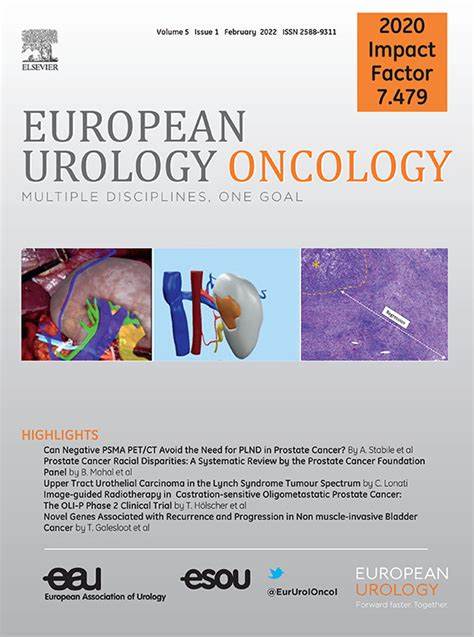The Natural History of Confirmed Grade Group 1 Prostate Cancer Managed with Active Surveillance in the Modern Era
IF 9.3
1区 医学
Q1 ONCOLOGY
引用次数: 0
Abstract
Background and objective
Grade group 1 (GG1, Gleason 3 + 3) prostate cancer (PCa) is considered low risk but can upgrade, and is managed with active surveillance (AS). Amidst recent controversy of whether GG1 PCa should be called cancer, we determined the nature of progression of GG1 disease in a modern AS cohort with multiparametric magnetic resonance imaging (mpMRI) and genomic testing.
Methods
The Urologic Outcomes Database at the University of California San Francisco was queried for men with confirmed GG1 PCa. The primary outcome was biopsy upgrade (≥GG2, Gleason ≥3 + 4). The secondary outcomes included major upgrade (≥GG3, Gleason ≥4 + 3), metastasis, mortality, PCa-specific mortality, and active treatment after upgrade. Life table estimates, Kaplan-Meier analyses, and multivariable Cox proportional hazards regression models were performed.
Key findings and limitations
A total of 1429 men met the inclusion criteria. The 10-yr rates of upgrade and major upgrade were 62% and 19%, respectively. The 10-yr rates of metastasis, mortality, and PCa-specific mortality were 1.9%, 3.4%, and 0.1%, respectively. The 5-yr rate of active treatment after upgrade was 73%. On multivariable regression analyses, increasing age, percentage of positive cores, and prostate-specific antigen density, but not positive mpMRI, change in mpMRI, or high-risk genomics, were significantly associated with the risk of upgrade. Upgrade to ≥GG3 was the only factor associated with advancement to active treatment.
Conclusions and clinical implications
Men with confirmed GG1 PCa on AS have high rates of upgrade, and low rates of metastasis and mortality at 10 yr, confirming the appropriateness of AS. A high-risk genomic score, and initial positive mpMRI or change in mpMRI were not associated with upgrade outcomes, requiring further optimization.
现代积极监测下确诊的1级前列腺癌的自然历史
背景和目的:1级(GG1, Gleason 3 + 3)前列腺癌(PCa)被认为是低风险的,但可以升级,并通过主动监测(AS)进行管理。在最近关于GG1 PCa是否应该被称为癌症的争论中,我们通过多参数磁共振成像(mpMRI)和基因组检测确定了现代AS队列中GG1疾病进展的性质。方法:查询加州大学旧金山分校泌尿系统预后数据库中确诊为GG1型前列腺癌的男性。主要结局是活检升级(≥GG2, Gleason≥3 + 4)。次要结局包括主要升级(≥GG3, Gleason≥4 + 3)、转移、死亡率、pca特异性死亡率和升级后的积极治疗。进行生命表估计、Kaplan-Meier分析和多变量Cox比例风险回归模型。主要发现和局限性:共有1429名男性符合纳入标准。10年升级率和主要升级率分别为62%和19%。10年转移率、死亡率和前列腺癌特异性死亡率分别为1.9%、3.4%和0.1%。升级后5年积极治疗率为73%。在多变量回归分析中,年龄、核心阳性百分比和前列腺特异性抗原密度的增加与升级风险显著相关,但mpMRI阳性、mpMRI改变或高危基因组学与升级风险无关。升级到≥GG3是进展到积极治疗的唯一因素。结论和临床意义:确诊为GG1前列腺癌的AS患者,10年的升级率高,转移率低,死亡率低,证实了AS的适宜性。高风险基因组评分、初始mpMRI阳性或mpMRI改变与升级结果无关,需要进一步优化。
本文章由计算机程序翻译,如有差异,请以英文原文为准。
求助全文
约1分钟内获得全文
求助全文
来源期刊

European urology oncology
Multiple-
CiteScore
15.50
自引率
2.40%
发文量
128
审稿时长
20 days
期刊介绍:
Journal Name: European Urology Oncology
Affiliation: Official Journal of the European Association of Urology
Focus:
First official publication of the EAU fully devoted to the study of genitourinary malignancies
Aims to deliver high-quality research
Content:
Includes original articles, opinion piece editorials, and invited reviews
Covers clinical, basic, and translational research
Publication Frequency: Six times a year in electronic format
 求助内容:
求助内容: 应助结果提醒方式:
应助结果提醒方式:


